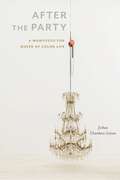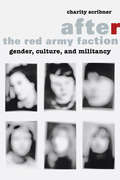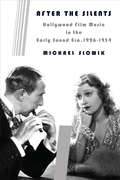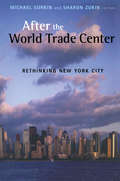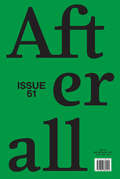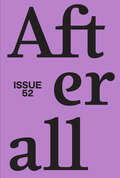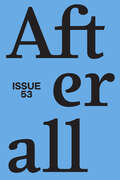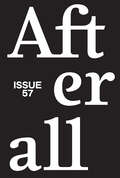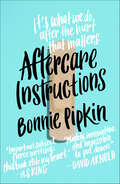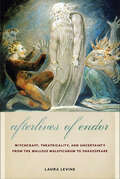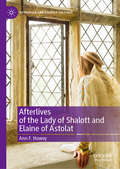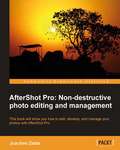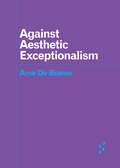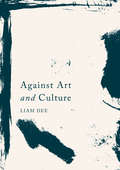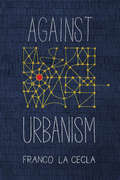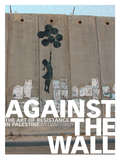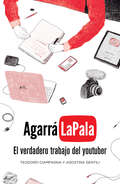- Table View
- List View
After the Party: A Manifesto for Queer of Color Life (Sexual Cultures #4)
by Joshua Chambers-LetsonWinner, 2019 ATHE Outstanding Book Award, given by the Association for Theatre in Higher EducationWinner, 2018 Errol Hill Award in African American theater, drama, and/or performance studies, presented by the American Society for Theatre ResearchA new manifesto for performance studies on the art of queer of color worldmaking. After the Party tells the stories of minoritarian artists who mobilize performance to produce freedom and sustain life in the face of subordination, exploitation, and annihilation. Through the exemplary work of Nina Simone, Jorge Ignacio Cortiñas, Danh Vō, Felix Gonzalez-Torres, Eiko, and Tseng Kwong Chi, and with additional appearances by Nao Bustamante, Audre Lorde, Martin Wong, Assata Shakur, and Nona Faustine, After the Party considers performance as it is produced within and against overlapping histories of US colonialism, white supremacy, and heteropatriarchy. Building upon the thought of José Esteban Muñoz alongside prominent scholarship in queer of color critique, black studies, and Marxist aesthetic criticism, Joshua Chambers-Letson maps a portrait of performance’s capacity to produce what he calls a communism of incommensurability, a practice of being together in difference. Describing performance as a rehearsal for new ways of living together, After the Party moves between slavery, the Civil Rights Movement, the first wave of the AIDS crisis, the Vietnam War, and the catastrophe-riddled horizon of the early twenty-first century to consider this worldmaking practice as it is born of the tension between freedom and its negation. With urgency and pathos, Chambers-Letson argues that it is through minoritarian performance that we keep our dead alive and with us as we struggle to survive an increasingly precarious present.
After the Red Army Faction
by Charity ScribnerAnalyzing the afterimage of revolutionary violence in contemporary culture and politics. Utopia or Auschwitz: Germany's 1968 Generation and the Holocaust
After the Red Army Faction: Gender, Culture, and Militancy
by Charity ScribnerMasterminded by women, the Red Army Faction (RAF) terrorized West Germany from the 1970s to the 1990s. Afterimages of its leaders persist in the works of pivotal artists and writers, including Gerhard Richter, Elfriede Jelinek, and Slavoj i ek. Why were women so prominent in the RAF? What does the continuing cultural response to the German armed struggle tell us about the representation of violence, power, and gender today? Engaging critical theory, Charity Scribner addresses these questions and analyzes signal works that point beyond militancy and terrorism. This literature and art discloses the failures of the Far Left and registers the radical potential that RAF women actually forfeited.After the Red Army Faction maps out a cultural history of militancy and introduces "postmilitancy" as a new critical term. <P><P>As Scribner demonstrates, the most compelling examples of postmilitant culture don't just repudiate militancy: these works investigate its horizons of possibility, particularly on the front of sexual politics. Objects of analysis include as-yet untranslated essays by Theodor Adorno and Jürgen Habermas, as well as novels by Friedrich Dürrenmatt and Judith Kuckart, Johann Kresnik's Tanztheaterstück Ulrike Meinhof, and the blockbuster exhibition Regarding Terror at the Berlin Kunst-Werke. Scribner focuses on German cinema, offering incisive interpretations of films by Margarethe von Trotta, Volker Schlöndorff, and Fatih Akin, as well as the international box-office success The Baader-Meinhof Complex. These readings disclose dynamic junctures among several fields of inquiry: national and sexual identity, the disciplining of the militant body, and the relationship between mass media and the arts.
After the Silents
by Michael SlowikViewing more than two hundred films from the period, Michael Slowik launches the first comprehensive study of a long-neglected phase in Hollywood's initial development
After the Silents: Hollywood Film Music in the Early Sound Era, 1926-1934 (Film and Culture Series)
by Michael SlowikMany believe Max Steiner's score for King Kong (1933) was the first important attempt at integrating background music into sound film, but a closer look at the industry's early sound era (1926–1934) reveals a more extended and fascinating story. Viewing more than two hundred films from the period, Michael Slowik launches the first comprehensive study of a long-neglected phase in Hollywood's initial development, recasting the history of film sound and its relationship to the "Golden Age" of film music (1935–1950). <P><P>Slowik follows filmmakers' shifting combinations of sound and image, recapturing the volatility of this era and the variety of film music strategies that were tested, abandoned, and kept. He explores early film music experiments and accompaniment practices in opera, melodrama, musicals, radio, and silent films and discusses the impact of the advent of synchronized dialogue. He concludes with a reassessment of King Kong and its groundbreaking approach to film music, challenging the film's place and importance in the timeline of sound achievement.
After the World Trade Center: Rethinking New York City (Cultural Spaces)
by Michael Sorkin Sharon ZukinThe terrorist attacks of September 11 have created an unprecedented public discussion about the uses and meanings of the central area of lower Manhattan that was once the World Trade Center. While the city sifts through the debris, contrary forces shaping its future are at work. Developers jockey to control the right to rebuild "ground zero." Financial firms line up for sweetheart deals while proposals for memorials are gaining in appeal. In After the World Trade Center, eminent social critics Sharon Zukin and Michael Sorkin call on New York's most acclaimed urbanists to consider the impact of the terrorist attack on the World Trade Center and what it bodes for the future of New York. Contributors take a close look at the reaction to the attack from a variety of New York communities and discuss possible effects on public life in the city.
Afterall: A Journal of Art, Context and Enquiry, volume 51 number 1 (Spring 2021)
by Afterall: A Journal of Art, Context and EnquiryThis is volume 51 issue 1 of Afterall: A Journal of Art, Context and Enquiry. Afterall is a journal of contemporary art that provides in-depth analysis of art and its social, political, and philosophical contexts. Each issue provides the reader with well-researched contributions that discuss each artist's work from different perspectives. Contextual essays and other texts discussing events, works, or exhibitions further develop the thematic focus of each issue.
Afterall: A Journal of Art, Context and Enquiry, volume 52 number 1 (Autumn/Winter 2021)
by Afterall: A Journal of Art, Context and EnquiryThis is volume 52 issue 1 of Afterall: A Journal of Art, Context and Enquiry. Afterall is a journal of contemporary art that provides in-depth analysis of art and its social, political, and philosophical contexts. Each issue provides the reader with well-researched contributions that discuss each artist's work from different perspectives. Contextual essays and other texts discussing events, works, or exhibitions further develop the thematic focus of each issue.
Afterall: A Journal of Art, Context and Enquiry, volume 53 number 1 (Spring 2022)
by Afterall: A Journal of Art, Context and EnquiryThis is volume 53 issue 1 of Afterall: A Journal of Art, Context and Enquiry. Afterall is a journal of contemporary art that provides in-depth analysis of art and its social, political, and philosophical contexts. Each issue provides the reader with well-researched contributions that discuss each artist's work from different perspectives. Contextual essays and other texts discussing events, works, or exhibitions further develop the thematic focus of each issue.
Afterall: A Journal of Art, Context and Enquiry, volume 54 number 1 (Autumn/Winter 2022)
by Afterall: A Journal of Art, Context and EnquiryThis is volume 54 issue 1 of Afterall: A Journal of Art, Context and Enquiry. Afterall is a journal of contemporary art that provides in-depth analysis of art and its social, political, and philosophical contexts. Each issue provides the reader with well-researched contributions that discuss each artist's work from different perspectives. Contextual essays and other texts discussing events, works, or exhibitions further develop the thematic focus of each issue.
Afterall: A Journal of Art, Context and Enquiry, volume 55-56 number 1 (Spring 2023)
by Afterall: A Journal of Art, Context and EnquiryThis is volume 55-56 issue 1 of Afterall: A Journal of Art, Context and Enquiry. Afterall is a journal of contemporary art that provides in-depth analysis of art and its social, political, and philosophical contexts. Each issue provides the reader with well-researched contributions that discuss each artist's work from different perspectives. Contextual essays and other texts discussing events, works, or exhibitions further develop the thematic focus of each issue.
Afterall: A Journal of Art, Context and Enquiry, volume 57 number 1 (Spring 2024)
by Afterall: A Journal of Art, Context and EnquiryThis is volume 57 issue 1 of Afterall: A Journal of Art, Context and Enquiry. Afterall is a journal of contemporary art that provides in-depth analysis of art and its social, political, and philosophical contexts. Each issue provides the reader with well-researched contributions that discuss each artist's work from different perspectives. Contextual essays and other texts discussing events, works, or exhibitions further develop the thematic focus of each issue.
Aftercare Instructions: A Novel
by Bonnie PipkinEveryone is talking about Aftercare Instructions, Bonnie Pipkin’s electric debut novel:“Important, fierce. Pipkin stole my heart with this book.” —A.S. King, author of Still Life with Tornado“Mighty, innovative, and nearly impossible to put down.” —David Arnold, author of Kids of Appetite“Incredibly honest and empathetic.” —ALA Booklist“Big-hearted, sensitive, and engrossing.” —Publishers Weekly“Troubled.” That’s seventeen-year-old Genesis according to her small New Jersey town. She finds refuge and stability in her relationship with her boyfriend, Peter—until he abandons her at a Planned Parenthood clinic during their appointment to terminate an unwanted pregnancy. The betrayal causes Gen to question everything.As Gen pushes herself forward to find her new identity without Peter, she must also confront her most painful memories. Through the lens of an ongoing four act play within the novel, the fantasy of their undying love unravels line by line, scene by scene. Digging deeper into her past while exploring the underground theater world of New York City, she rediscovers a long forgotten dream. But it’s when Gen lets go of her history, the one she thinks she knows, that she’s finally able to embrace the complicated, chaotic true story of her life, and take center stage.Aftercare Instructions, a debut full of heart and hope, follows Gen on a big-hearted journey from dorm rooms to diners to underground theaters—and ultimately, right into readers' hearts.
Afterimage
by Kevin J. Anderson Kristine Kathryn RuschThe strange people had restored her life after she had been raped and burned nearly to death. The only model they had to work with was her assailant.
Afterimages
by Arlene CroceDancing leaves nothing else behind--no record, no text--and so the afterimage becomes the subject of dance criticism. A dance critic tries to train the memory as well as the organs of sense; he tries to make the afterimage that appears in his writing match the performance. 10 years of reviews of dancing, from ballet to Balanchine to Twyla Tharp.
Afterimages
by Liam KennedyIn 2005, photographer Chris Hondros captured a striking image of a young Iraqi girl in the aftermath of the killing of her parents by American soldiers. The shot stunned the world and has since become iconic--comparable to the infamous photo by Nick Ut of a Vietnamese girl running from a napalm attack. Both images serve as microcosms for their respective conflicts. Afterimages looks at the work of war photographers like Hondros and Ut to understand how photojournalism interacts with the American worldview. Liam Kennedy here maps the evolving relations between the American way of war and photographic coverage of it. Organized in its first section around key US military actions over the last fifty years, the book then moves on to examine how photographers engaged with these conflicts on wider ethical and political grounds, and finally on to the genre of photojournalism itself. Illustrated throughout with examples of the photographs being considered, Afterimages argues that photographs are important means for critical reflection on war, violence, and human rights. It goes on to analyze the high ethical, sociopolitical, and legalistic value we place on the still image's ability to bear witness and stimulate action.
Afterlives of Endor: Witchcraft, Theatricality, and Uncertainty from the "Malleus Maleficarum" to Shakespeare
by Laura LevineAfterlives of Endor offers an analysis of the way early modern English literature addressed the period's anxieties about witchcraft and theatricality. What determined whether or not a demonologist imagined a trial as a spectacle? What underlying epistemological constraints governed such choices and what conceptions of witchcraft did these choices reveal? Pairing readings of demonological texts with canonical plays and poetry, Laura Levine examines such questions. Through analyses of manuals and pamphlets about the prosecution of witches—including Reginald Scot's skeptical The Discoverie of Witchcraft (1584), King James VI/I's Daemonologie (1597), and Jean Bodin's De la Demonomanie des Sorciers (1580)—Afterlives of Endor examines the way literary texts such as Shakespeare's The Winter's Tale and The Tempest, Spenser's The Faerie Queene, and Marlowe's Tragicall History of Doctor Faustus address anxieties about witchcraft, illusion, and theatricality. Afterlives of Endor attends to the rhetorical tactics, argumentative investments, and underlying tensions of demonological texts with the scrutiny ordinarily reserved for literary texts.
Afterlives of the Lady of Shalott and Elaine of Astolat (Arthurian and Courtly Cultures)
by Ann F. HoweyThis book investigates adaptations of The Lady of Shalott and Elaine of Astolat in Victorian and post-Victorian popular culture to explore their engagement with medievalism, social constructions of gender, and representations of the role of art in society. Although the figure of Elaine first appeared in medieval texts, including Malory’s Le Morte Darthur, Tennyson’s poems about the Lady and Elaine drew unprecedented response from musicians, artists, and other authors, whose adaptations in some cases inspired further adaptations. With chapters on music, art, and literature (including parody, young people’s literature, and historical fiction and fantasy), this book seeks to trace the evolution of these characters and the ways in which they reinforce or challenge conventional gender roles, represent the present’s relationship to the past, and highlight the power of art.
Aftershot Pro: Non-destructive photo editing and management
by Joachim ZiebsThe book takes a tutorial approach.This book is great for photographers who want to start working with AfterShot Pro. It is assumed that you have a digital camera that can save RAW files to make use of the application. Readers are expected to have one or more RAW files available which can be used for practice alongside this book. Experience with other image editing software is a plus, but not mandatory for this book.
Against Aesthetic Exceptionalism (Forerunners: Ideas First)
by Arne De BoeverReconsiders exceptionalism between aesthetics and politics Here, Arne De Boever proposes the notion of aesthetic exceptionalism to describe the widespread belief that art and artists are exceptional. Against Aesthetic Exceptionalism challenges that belief by focusing on the sovereign artist as genius, as well as the original artwork as the foundation of the art market. Engaging with sculpture, conceptual artwork, and painting by emerging and established artists, De Boever proposes a worldly, democratic notion of unexceptional art as an antidote to the problems of aesthetic exceptionalism.Forerunners: Ideas First Short books of thought-in-process scholarship, where intense analysis, questioning, and speculation take the lead
Against Art and Culture
by Liam DeeOffering a negative definition of art in relation to the concept of culture, this book establishes the concept of 'art/culture' to describe the unity of these two fields around named-labour, idealised creative subjectivity and surplus signification. Contending a conceptual and social reality of a combined 'art/culture' , this book demonstrates that the failure to appreciate the dynamic totality of art and culture by its purported negators is due to almost all existing critiques of art and culture being defences of a 'true' art or culture against 'inauthentic' manifestations, and art thus ultimately restricting creativity to the service of the bourgeois commodity regime. While the evidence that art/culture enables commodification has long been available, the deduction that art/culture itself is fundamentally of the world of commodification has failed to gain traction. By applying a nuanced analysis of both commodification and the larger systems of ideological power, the book considers how the 'surplus' of art/culture is used to legitimate the bourgeois status quo rather than unravel it. It also examines possibilities for a post-art/culture world based on both existing practices that challenge art/culture identity as well as speculations on the integration of play and aesthetics into general social life. An out-and-out negation of art and culture, this book offers a unique contribution to the cultural critique landscape.
Against Urbanism (Green Arcade)
by Franco La CeclaAfter demolishing the myth of the rock star architect with his book Against Architecture, Franco La Cecla now explores the decisive challenges that cities are going to have to confront in the near future. Urban planning and development has become increasingly inadequate in response to the daily realities of life in our cities. Human, economic, ethnic, and environmental factors are systematically overlooked in city planning and housing development, and anachronistic, sterile, and formalistic architecture almost invariably prevails. Never more than today has democracy played itself out in public spaces, sidewalks, and streets. Urban planners and developers, however, are still prisoners of an obsolete vision of passivity which betrays actual city needs and demands. A new urban science is required which can, first of all, guarantee a civil, dignified life for all—urban development which ensures the right to a humane mode of daily living, which has been and still is completely ignored.
Against the Commons: A Radical History of Urban Planning
by Álvaro Sevilla-BuitragoAn alternative history of capitalist urbanization through the lens of the commons Characterized by shared, self-managed access to food, housing, and the basic conditions for a creative life, the commons are essential for communities to flourish and protect spaces of collective autonomy from capitalist encroachment. In a narrative spanning more than three centuries, Against the Commons provides a radical counterhistory of urban planning that explores how capitalism and spatial politics have evolved to address this challenge.Highlighting episodes from preindustrial England, New York City and Chicago between the 1850s and the early 1900s, Weimar-era Berlin, and neoliberal Milan, Álvaro Sevilla-Buitrago shows how capitalist urbanization has eroded the egalitarian, convivial life-worlds around the commons. The book combines detailed archival research with provocative critical theory to illuminate past and ongoing struggles over land, shared resources, public space, neighborhoods, creativity, and spatial imaginaries.Against the Commons underscores the ways urbanization shapes the social fabric of places and territories, lending particular awareness to the impact of planning and design initiatives on working-class communities and popular strata. Projecting history into the future, it outlines an alternative vision for a postcapitalist urban planning, one in which the structure of collective spaces is ultimately defined by the people who inhabit them.
Against the Wall: The Art of Resistance in Palestine
by William ParryFeaturing the work of acclaimed artists such as Banksy, Ron English, and Blu, as well as Palestinian artists and activists, the photographs in this collection express outrage, compassion, and touching humor while illustrating the lives and livelihoods of the tens of thousands of people affected by Israel's wall. This stunning book of photographs details the graffiti and art that have transformed Israel's Wall of Separation into a canvas of symbolic resistance and solidarity. The compelling images are interspersed with vignettes of the people whose lives are affected by the wall and who suffer due to a lack of work, education, and vital medical care.
Agarrá la pala: El verdadero trabajo del youtuber
by Teodoro Ciampagna Alejandro Bacile¿Cuál es el verdadero trabajo del youtuber? Ellos mismos te lo cuentan. Mucho se habla de que los youtubers son un montón de vagos que hace pavadas frentes a una camarita. Lo cierto es que cambiaron el paradigma de la comunicación y son los dueños de la audiencia de todas las edades; cada uno con su talento particular. ¿Cuál es su verdadero trabajo? ¿Cuánto tiempo les lleva? ¿Por qué lo hacen? ¿Son todos amigos o hay rivalidades? Esas y muchas otras preguntas más son respondidas en este libro por los youtubers más importantes de la Argentina.
